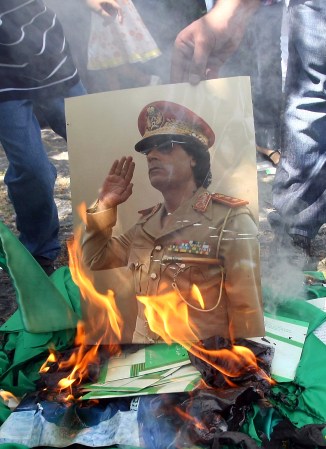
Muammar Gaddafi's portrait and his green books burn outside the Libyan embassy in Turkey / AFP photo by Adem Altan / Getty Images
So the U.S. was able to spearhead the imminent collapse of Muammar Gaddfi’s regime in Libya on the cheap. We launched full-fledged invasions of Afghanistan and Iraq against murderous tyrants, but elected not to do the same in Libya. Is this a new template for U.S. wars, or just an acknowledgement of a war-weary nation?
It’s a little of both, actually. President Obama, who was elected, in part, to help wind down those two post-9/11 wars, had no desire to begin a third. But he was willing to help NATO and the Arab League by providing a precision-guided attacks in the Libyan war’s first two weeks, before taking a decidedly back seat for the next five months. The U.S. left the bulk of the bombing to British and French forces (although a tweezerful of armed, unmanned U.S. Predators have been hitting key targets inside Libya for months now).
Time is always an ally of one side or another in a conflict. Bottom line: even as the rebels waged war among themselves — killing a top general recently — the allied bombing, night after night, was taking its toll, like kinetic Chinese water torture. “The future of Libya is now in the hands of the Libyan people,” Obama said in a statement Sunday night. “We will continue to work with our allies and partners in the international community to protect the people of Libya, and to support a peaceful transition to democracy.”
Gaddafi, who remains in hiding, plainly felt he could outlast rebel attacks and NATO airstrikes. While the Libyan leader may be delusional, he had grounds for his hunch. But NATO — despite its meager arsenal and internal disputes — stuck to its guns for nearly six months. It actually has little choice, and this is where Gaddafi misjudged: if the most powerful military alliance in the history of the world couldn’t squash Libya’s forces, just what is its purpose? The looming rebel victory in Libya allows NATO to prepare to plan to fight another day.
In fact, NATO Secretary General Anders Fogh Rasmussen thinks the Libyan operation could act as a blueprint for a less U.S.-centric way of waging war. “We have been used to the fact that the U.S. should be in the very front line, and absolutely be in the lead, to carry out NATO operations,” he told TIME in May. “How could it be that the U.S. should always take the lion’s share of the burden — couldn’t European allies step up to the plate?”
Through Saturday, NATO had conducted 19,751 sorties over Libya, including 7,459 ground-attack missions, since March 31. On Saturday, 105 sorties were flown, including 36 strike missions against targets near Tripoli, Brega, Gharyan, Sirte and Zlitan. The targets included military facilities, command and control nodes, and both surface-to-air and surface-to-surface missile sites.
The repeated strikes ultimately made it difficult for Gaddafi loyalists to communicate and coordinate with one another. That, in turn, leveled the playing field between them and the rebels, who over time have become more adept at command and control of their forces. In the Mediterranean, 18 vessels were hailed — one boarded, another diverted — as the allies maintained an arms blockade against Libya. Since March 31, allied naval forces have hailed 2,276 vessels, boarded 228, and diverted 10.
Once Gaddafi is ousted, killed, or flees into exile, the real work begins: rebuilding a nation that has lacked basic civilian institutions for 42 years is not going to happen easily, or quickly. The victorious rebels are salted with human-rights abusers and the lack of a foe could trigger fissures in the Transitional National Council. As we have learned way too clearly in Kabul and Baghdad, toppling a tyrant is the easy part of the job.


